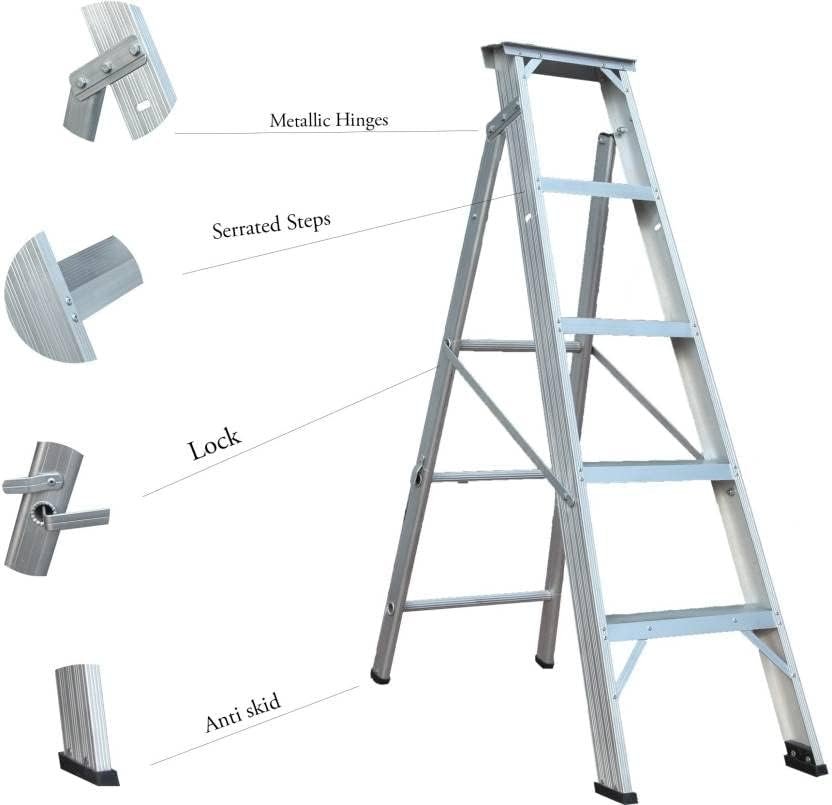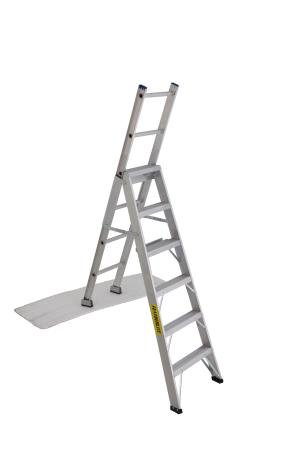Shop Now-تسوق الآن
Description
لمعرفة سعر هذا المنتج وللطلب مباشرة ولمزيد من المعلومات يرجى التواصل معنا على
To know the price of this product, to order directly, and for more information, please contact us at:
BRANCH AL QUNFUDHA: +966543146949 (click on this Number call us)
BRANCH AL QUOZ: +966505135675 (click on this Number call us)
للاستفسار عن الأسعار وطلب المزيد من التفاصيل اتصل بنا الآن:
فرع القنفذة: 966543146949+
فرع القوز: 966505135675+
Enquiry on whatsapp: “https://api.whatsapp.com/send?phone=966543146949&text=PRODUCT%20ENQUIRY”
تفاصيل المنتج:
السلالم هي أدوات متعددة الاستخدامات تستخدم للتسلق والوصول إلى المرتفعات وأداء المهام في مختلف الصناعات والأسر. فيما يلي نظرة عامة على السلالم بناءً على الأنواع والمواد والتطبيقات:
1. أنواع السلالم
أ. سلالم متدرجة
الوصف: سلالم ذاتية الدعم على شكل حرف A بدرجات عريضة.
الاستخدام الشائع: المهام الداخلية أو الطلاء أو الوصول إلى الأرفف.
الميزات: غالبًا ما تكون قابلة للطي للتخزين السهل.
ب. سلالم قابلة للتمديد
الوصف: قسمان ينزلقان لتمديد الارتفاع.
الاستخدام الشائع: الأعمال الخارجية مثل صيانة المباني أو الوصول إلى الأسطح.
الميزات: تتطلب هيكلًا مستقرًا للدعم.
ج. سلالم منصة
الوصف: تشبه سلالم المتدرجة ولكن بمنصة مسطحة في الأعلى.
الاستخدام الشائع: المهام الطويلة التي تتطلب ثباتًا أثناء الوقوف.
الميزات: منصة آمنة غير قابلة للانزلاق مع درابزين للتوازن.
د. سلالم مستقيمة
الوصف: سلالم غير قابلة للتعديل تتكئ على الهياكل.
الاستخدام الشائع: المهام البسيطة مثل تنظيف النوافذ أو إصلاحات الإضاءة.
المميزات: خفيفة الوزن ولكنها تتطلب سطحًا داعمًا.
E. سلالم متعددة الأغراض
الوصف: سلالم قابلة للتحويل مع تكوينات متعددة (على سبيل المثال، درجة، امتداد، سقالة).
الاستخدام الشائع: وظائف متعددة في الداخل والخارج.
الميزات: قابلة للتعديل للتخزين المدمج.
F. سلالم تلسكوبية
الوصف: سلالم قابلة للتمديد تنهار لسهولة الحمل.
الاستخدام الشائع: تخزين مدمج ووصول سريع في الأماكن الضيقة.
الميزات: خفيفة الوزن، وقابلة للتمديد، وسهلة النقل.
G. سلالم العلية
الوصف: سلالم قابلة للطي مثبتة للوصول إلى العلية.
الاستخدام الشائع: الوصول إلى التخزين المنزلي.
الميزات: موفرة للمساحة، قابلة للسحب.
H. سلالم ثابتة
الوصف: مثبتة بشكل دائم بالهياكل (على سبيل المثال، المباني والصوامع).
الاستخدام الشائع: الوصول الصناعي للصيانة.
الميزات: متينة للغاية مع أقفاص أمان في بعض الحالات.
2. مواد السلم
أ. الألومنيوم
المزايا: خفيفة الوزن، ومقاومة للتآكل، ومتينة.
الأفضل لـ: المهام العامة والطلاء والأعمال الكهربائية حيث لا يلزم العزل.
القيود: موصل للكهرباء (ليس مثاليًا للأعمال الكهربائية الحية).
ب. الألياف الزجاجية
المزايا: غير موصلة للكهرباء وقوية ومقاومة للطقس.
الأفضل لـ: الأعمال الكهربائية والاستخدام الخارجي.
القيود: أثقل من الألومنيوم.
ج. الخشب
المزايا: غير موصلة للكهرباء وبأسعار معقولة.
الأفضل لـ: المهام المنزلية الخفيفة.
القيود: عرضة للتلف بسبب الطقس والتحلل بمرور الوقت.
د. الفولاذ
المزايا: قوية جدًا ومتينة.
الأفضل لـ: المهام الصناعية الشاقة.
القيود: عرضة للصدأ إذا لم يتم طلائها بشكل صحيح.
هـ. البلاستيك/المركب
المزايا: خفيفة الوزن ومقاومة للتآكل.
الأفضل لـ: التطبيقات المتخصصة (على سبيل المثال، صيانة حمامات السباحة).
القيود: سعة تحميل أقل مقارنة بالخيارات المعدنية.
3. ميزات السلامة
خطوات مضادة للانزلاق: تقلل من الانزلاق أثناء التسلق.
مثبتات/أذرع تثبيت: تعزز الثبات على الأسطح غير المستوية.
قضبان الأمان: توفر الدعم أثناء الاستخدام.
تصنيفات الحمل: تأكد من أن السلالم تدعم فئات الوزن المحددة.
4. تصنيفات سعة الحمل
النوع IAA: 375 رطلاً (مهام صناعية شديدة التحمل)
النوع IA: 300 رطلاً (استخدامات ثقيلة التحمل)
النوع I: 250 رطلاً (صناعي)
النوع II: 225 رطلاً (مهام متوسطة التحمل)
النوع III: 200 رطل (استخدام منزلي خفيف)
5. التطبيقات
المنزلية: التنظيف والديكور والإصلاحات الخفيفة.
الصناعية: البناء والصيانة والمهام الكهربائية.
التجارية: إصلاح المستودعات والتجزئة والمكاتب.
التخصصية: حمامات السباحة والسندرات والوصول إلى الآلات الصناعية.
الملخص
يعتمد اختيار السلم المناسب على:
الغرض (منزلي، تجاري، صناعي).
متطلبات الارتفاع.
سعة التحميل (تصنيفات الوزن).
مادة للسلامة والمتانة.
Ladders are versatile tools used for climbing, reaching heights, and performing tasks in various industries and households. Here’s an overview of ladders based on types, materials, and applications:
1. Types of Ladders
A. Step Ladders
Description: Self-supporting, A-shaped ladders with wide steps.
Common Use: Indoor tasks, painting, or reaching shelves.
Features: Often foldable for easy storage.
B. Extension Ladders
Description: Two sections that slide to extend height.
Common Use: Outdoor work like building maintenance or accessing roofs.
Features: Requires a stable structure for support.
C. Platform Ladders
Description: Similar to step ladders but with a flat platform at the top.
Common Use: Long tasks requiring standing stability.
Features: Safe, non-slip platform with a railing for balance.
D. Straight Ladders
Description: Non-adjustable ladders that lean against structures.
Common Use: Simple tasks like cleaning windows or light repairs.
Features: Lightweight but requires a supporting surface.
E. Multi-Purpose Ladders
Description: Convertible ladders with multiple configurations (e.g., step, extension, scaffolding).
Common Use: Versatile jobs indoors and outdoors.
Features: Adjustable for compact storage.
F. Telescoping Ladders
Description: Extendable ladders that collapse for portability.
Common Use: Compact storage and quick access in tight spaces.
Features: Lightweight, extendable, and easy to transport.
G. Attic Ladders
Description: Foldable ladders installed to access attics.
Common Use: Home storage access.
Features: Space-saving, retractable.
H. Fixed Ladders
Description: Permanently attached to structures (e.g., buildings, silos).
Common Use: Industrial access for maintenance.
Features: Highly durable with safety cages in some cases.
2. Ladder Materials
A. Aluminum
Advantages: Lightweight, corrosion-resistant, and durable.
Best For: General tasks, painting, and electrical work where insulation isn’t required.
Limitations: Conducts electricity (not ideal for live electrical work).
B. Fiberglass
Advantages: Non-conductive, strong, and weather-resistant.
Best For: Electrical work and outdoor use.
Limitations: Heavier than aluminum.
C. Wood
Advantages: Non-conductive and affordable.
Best For: Light household tasks.
Limitations: Susceptible to weather damage and decay over time.
D. Steel
Advantages: Very strong and durable.
Best For: Heavy-duty industrial tasks.
Limitations: Prone to rust if not properly coated.
E. Plastic/Composite
Advantages: Lightweight and corrosion-resistant.
Best For: Specialized applications (e.g., pool maintenance).
Limitations: Lower load capacity compared to metal options.
3. Safety Features
Anti-slip steps: Reduces slipping during climbs.
Stabilizers/Outriggers: Enhances stability on uneven surfaces.
Safety rails: Provides support during use.
Load Ratings: Ensure ladders support designated weight categories.
4. Load Capacity Ratings
Type IAA: 375 lbs. (Heavy-duty industrial tasks)
Type IA: 300 lbs. (Heavy-duty use)
Type I: 250 lbs. (Industrial)
Type II: 225 lbs. (Medium-duty tasks)
Type III: 200 lbs. (Light household use)
5. Applications
Household: Cleaning, decorating, and light repairs.
Industrial: Construction, maintenance, electrical tasks.
Commercial: Warehouses, retail, and office repairs.
Specialized: Pools, attics, and industrial machinery access.
Summary
Choosing the right ladder depends on:
Purpose (household, commercial, industrial).
Height requirements.
Load capacity (weight ratings).
Material for safety and durability.






Reviews
There are no reviews yet.